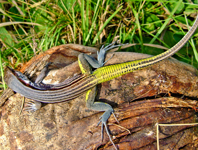Abstract
Several species of Glaucomastix lizards have been described over the past decade, most of these inhabit inland Brazil. Glaucomastix abaetensis is a threatened whiptail endemic to Brazilian coastal “restinga” (sandy habitats) from Bahia State to Sergipe, with a distribution limited by riverine barriers. In order to investigate the differentiation and relationships in G. abaetensis, we integrated phylogeographic analysis, Bayesian species delimitation and morphological data to detect geographical patterns and historical events responsible for its present distribution. We recovered two highly divergent clades along its range, one of them unnamed. Glaucomastix itabaianensis sp. nov. has a a yellowish green tail, 13–16 scales in the lateral flank, 22–33 scales around tail, 28–35 femoral pores and usually four supraocular scales with the smaller one disposed posteriorly. Our results retrieved the monophyly of Glaucomastix, with G. venetacauda and G. cyanurus being sister species to a clade formed by G. littoralis and G. abaetensis. Divergence between Glaucomastix abaetensis and the new species occurred roughly 2.39 Myr ago; posterior shallow genetic divergences occurred mainly in Pleistocene. Finally, we present data on the conservation of this clade of whiptail lizards.
References
Arévalo, E., Davis, S.K. & Sites Jr, J.W. (1994) Mitochondrial DNA sequence divergence and phylogenetic relationships among eight chromosome races of the Sceloporus grammicus Complex (Phrynosomatidae) in Central Mexico. Systematic Biology, 43 (3), 387–418.
Bickham, J.W., Wood, C.C. & Patton, J.C. (1995) Biogeographic implications of cytochrome b sequences and allozymes in sockeye (Oncorhynchus nerka). Journal of Heredity, 86 (2), 140–144.
Harvey, M.B., Ugueto, G.N. & Gutberlet Jr, R.L. (2012) Review of teiid morphology with a revised taxonomy and phylogeny of the Teiidae (Lepidosauria: Squamata). Zootaxa, 3459, 1–156.
Kim, S.U. (2009) Survival and Regeneration of Adult Human Retinal Neurons and Photoreceptors in Co-Culture with Human Astrocytes. Tissue Engineering and Regenerative Medicine, 6, 623–628.
Miller, M.P. (2005) Alleles In Space (AIS): computer software for the joint analysis of interindividual spatial and genetic information. Journal of Heredity, 96, 722–724.
Pellegrino, K.C.M., Rodrigues, M.T., Yassuda, Y.Y. & Sites Jr, J.W. (2001) A molecular perspective on the evolution of microteiid lizards (Squamata, Gymnophthalmidae), and a new classification for the family. Biological Journal of the Linnean Society, 74 (3), 317–340.
Townsend, T.M., Alegre, R.E., Kelley, S.T., Wiens, J.J. & Reeder, T.W. (2008) Rapid development of multiple nuclear loci for phylogenetic analysis using genomic resources: an example from squamate reptiles. Molecular Phylogenetics and Evolution, 47 (1), 129–142.

